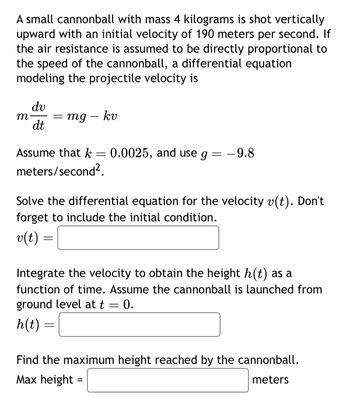
Advanced Engineering Mathematics
10th Edition
ISBN: 9780470458365
Author: Erwin Kreyszig
Publisher: Wiley, John & Sons, Incorporated
expand_more
expand_more
format_list_bulleted
Question

Transcribed Image Text:A small cannonball with mass 4 kilograms is shot vertically
upward with an initial velocity of 190 meters per second. If
the air resistance is assumed to be directly proportional to
the speed of the cannonball, a differential equation
modeling the projectile velocity is
dv
m
= mg
mg - kv
dt
Assume that k
=
0.0025, and use g =
-9.8
meters/second².
Solve the differential equation for the velocity v(t). Don't
forget to include the initial condition.
v(t) =
=
Integrate the velocity to obtain the height h(t) as a
function of time. Assume the cannonball is launched from
ground level at t = 0.
h(t) =
Find the maximum height reached by the cannonball.
Max height =
meters
Expert Solution
This question has been solved!
Explore an expertly crafted, step-by-step solution for a thorough understanding of key concepts.
Step by stepSolved in 2 steps with 2 images

Knowledge Booster
Similar questions
- A population of ladybugs begins with 50 ladybugs and increases at a rate of l'(t) ladybugs per week. What does 50 + SI'(t) dt represent?arrow_forwardSuppose we throw a stone up into the air. It's velocity in meters/sec after t seconds is given by v (t) = 30 – 10t (a) Find the displacement of the stone from t seconds. = 0 seconds to t 30 (b) Find the total distance the stone travels from t = 0 seconds to t = 30 seconds.arrow_forwardPlease don't provide handwritten solution ....arrow_forward
- Let y(t) be the height (in meters) after time t (in seconds) of a rover that is landing on some other planet with the help of a parachute. Taking into account gravity and air resistance, physicists suggest that the air resistance is proportional to velocity. Further data suggests that the fall can be modeled by y"=-4-3y'. If the parachute is released at a height of 600m with an initial velocity of 0m/s, what is its height after t seconds? What is its terminal velocity? y(t) = The terminal velocity is m/s. m/sarrow_forwardLet y(t) be the height (in meters) after time t (in seconds) of a rover that is landing on some other planet with the help of a parachute. Taking into account gravity and air resistance, physicists suggest that the air resistance is proportional to velocity. Further data suggests that the fall can be modeled by y"=-5-3y'. If the parachute is released at a height of 600m with an initial velocity of 0m/s, what is its height after t seconds? What is its terminal velocity? y(t) = The terminal velocity is Submit m/s. m/sarrow_forwardالعنوان оне hot small copper ball [c in kJ/kg.°C, k in W/m.°C] is suddenly placed in water maintained at 100 °C. The convection heat transfer coefficient is h in W/m². ºC. Derive equation to calculate the time required to reduce ball to temperature T.arrow_forward
- The solution for t of the equation e^t=x is A. t= x/e B. t=lnx-1ne C. t=1nx D. t=1nx/earrow_forwardA A particular organism reproduces at a rate of f(t) = 22 population starts with 175 organisms, then how many carrow_forwardLet y(t) be the height (in meters) after time t (in seconds) of a rover that is landing on some other planet with the help of a parachute. Taking into account gravity and air resistance, physicists suggest that the air resistance is proportional to velocity. Further data suggests that the fall can be modeled by y"=-4-3y'. If the parachute is released at a height of 600m with an initial velocity of 0m/s, what is its height after t seconds? What is its terminal velocity? y(t) The terminal velocity is m/s. m/sarrow_forward
arrow_back_ios
arrow_forward_ios
Recommended textbooks for you
 Advanced Engineering MathematicsAdvanced MathISBN:9780470458365Author:Erwin KreyszigPublisher:Wiley, John & Sons, Incorporated
Advanced Engineering MathematicsAdvanced MathISBN:9780470458365Author:Erwin KreyszigPublisher:Wiley, John & Sons, Incorporated Numerical Methods for EngineersAdvanced MathISBN:9780073397924Author:Steven C. Chapra Dr., Raymond P. CanalePublisher:McGraw-Hill Education
Numerical Methods for EngineersAdvanced MathISBN:9780073397924Author:Steven C. Chapra Dr., Raymond P. CanalePublisher:McGraw-Hill Education Introductory Mathematics for Engineering Applicat...Advanced MathISBN:9781118141809Author:Nathan KlingbeilPublisher:WILEY
Introductory Mathematics for Engineering Applicat...Advanced MathISBN:9781118141809Author:Nathan KlingbeilPublisher:WILEY Mathematics For Machine TechnologyAdvanced MathISBN:9781337798310Author:Peterson, John.Publisher:Cengage Learning,
Mathematics For Machine TechnologyAdvanced MathISBN:9781337798310Author:Peterson, John.Publisher:Cengage Learning,


Advanced Engineering Mathematics
Advanced Math
ISBN:9780470458365
Author:Erwin Kreyszig
Publisher:Wiley, John & Sons, Incorporated

Numerical Methods for Engineers
Advanced Math
ISBN:9780073397924
Author:Steven C. Chapra Dr., Raymond P. Canale
Publisher:McGraw-Hill Education

Introductory Mathematics for Engineering Applicat...
Advanced Math
ISBN:9781118141809
Author:Nathan Klingbeil
Publisher:WILEY

Mathematics For Machine Technology
Advanced Math
ISBN:9781337798310
Author:Peterson, John.
Publisher:Cengage Learning,

